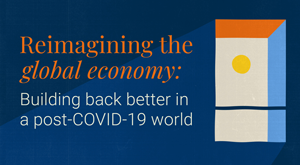This essay is part of “Reimagining the global economy: Building back better in a post-COVID-19 world,” a collection of 12 essays presenting new ideas to guide policies and shape debates in a post-COVID-19 world.
 The issue
The issue
The COVID-19 pandemic, and the carnage it has wrought on the world economy, has highlighted the need for a better global financial safety net that provides more protection for emerging market and developing economies (EMDEs). These countries, which face significant economic pressures even in normal times, have little room to maneuver when faced with such devastating global shocks. Given their rising importance in the world economy, helping these countries better withstand such shocks ought to be in the interest of even the advanced economies.
At the onset of the pandemic, EMDEs faced sudden stops of capital inflows and downward pressures on their exchange rates. Even for those countries with relatively sound macroeconomic fundamentals, financing conditions tightened as spreads on their sovereign bonds widened, in sharp contrast to the decline in government bond yields in advanced economies. Now many EMDEs, notably larger countries, are facing resurgent capital inflows due to the global low interest rate environment and the weakening of the dollar. While this provides temporary relief, such cycles of capital flow stalls and surges complicate macroeconomic management in these countries.
EMDEs will remain subject to capital flow and exchange rate volatility as major advanced economies rely on monetary policy measures, both conventional and unconventional, for economic support and the spillover effects of these policies cause whiplash effects. Reliance on dollar funding remains a source of vulnerability for many EMDEs, with the Fed’s actions and the dollar’s trajectory, in particular, affecting them considerably as a result.
Several EMDEs with high levels of external debt and balance of payments vulnerabilities have faced downgrades of their sovereign debt and lost access to global financial markets precisely at their time of greatest need to fight the pandemic and shore up their economies. Low‑income countries face even greater challenges. Their economies and export markets have collapsed, leaving many of them with crushing burdens of debt repayment. Sovereign debt levels were already high in many low-income countries and the pandemic is likely to make the situation worse as these countries have few other sources of domestic or foreign revenue to turn to.
Even before COVID-19, the global financial architecture was due for reforms to keep up with the evolving dynamics of the global economy, but the pandemic has highlighted the extent of these weaknesses, underscoring the need for reforms. It will take some bold actions on the part of the international community to make the global financial system better fit for purpose in the post-COVID world.
Sovereign debt levels were already high in many low-income countries and the pandemic is likely to make the situation worse as these countries have few other sources of domestic or foreign revenue to turn to.
The ideas
Recapitalize the IMF
A post-COVID-19 global financial system should incorporate a mechanism to systematically bolster the International Monetary Fund’s (IMF) lending capacity to a level commensurate with the increase in complexity of the financial system and the size of the global economy. The IMF is the most important institution in the global financial system to provide safety nets to countries in global financial crises, but its limited resources have constrained its ability to respond to the record number of requests for assistance.1 Cumulatively, the institution’s available resources amount to around $1 trillion, only 1.1 percent of global GDP. While this amount might be sufficient to provide financing for a few country crises, it is insufficient to manage systemic crises such as COVID-19 and, as global GDP continues to rise, these resources as a share of GDP will decline. An additional risk to the IMF’s resources and a major source of uncertainty for potential borrowers is the overreliance on non-quota resources for funding, namely the New Arrangements to Borrow (NAB) and bilateral borrowing agreements, which are temporary and are at the discretion of donor countries. These facilities are set to expire soon and, unless renewed, the IMF’s resources will decline to about $450 billion. The reliance on non-quota resources is inconsistent with the IMF’s basic principle that quota subscriptions should be the main source of resources.
Systematically deploy SDRs
The IMF’s ability to create new Special Drawing Rights (SDRs) is another tool in the global financial system’s arsenal that should be systematically deployed as needed to complement the existing lending facilities.2 The IMF has deployed this tool only four times in its history, most recently during the 2008-09 global financial crisis (GFC) in response to a call by the G-20. Its activation requires a super majority of 85 percent, which is significantly more than the combined voting share of all EMDEs. A proposal for issuing new SDRs as the pandemic spread through the world ran aground on account of the lack of super-majority support that was necessary.
Besides new SDRs, there may be previously created SDRs that have not been used by the beneficiary countries. To the extent that the pool of unused SDRs is sufficiently large, a reallocation from better resourced countries with access to alternative forms of funding to more needy countries could be helpful as well. The reallocation of the existing SDRs is largely voluntary, which limits the IMF’s ability to use this tool effectively. As such, the deployment of SDRs depends entirely on the will of the majority shareholders in the case of new SDRs or the will of holders of allocated and unused SDRs. A mechanism that empowers the IMF to reallocate SDRs to where they are most needed will be an improvement.
Establish swap lines accessible to a broader range of countries
A third reform would be to establish a framework to systematically expand access to temporary foreign exchange liquidity to a wide range of countries. The bilateral swap arrangements, which have become a common tool among central banks of advanced economies during global shocks since the GFC, are not available to most EMDEs to alleviate their foreign exchange liquidity shortages. During the COVID-19 pandemic, the swap lines offered by the Federal Reserve have helped provide dollar liquidity to global financial markets. However, most of these swap lines are with the central banks of other advanced economies. At the height of the pandemic, the Fed did offer dollar funding lines to more countries, collateralized by their central banks’ holdings of U.S. Treasury securities. But such ad hoc measures fall short of a more structured approach. Institutionalized mechanisms for emergency liquidity assistance would be more effective and would also reduce the incentive for EMDEs to undertake self-insurance through reserve accumulation, which is inefficient at both the national and global levels.
Improve debt restructuring mechanisms
In the absence of a sufficiently strong global safety net, the G-20 announced a debt standstill initiative (DSSI), calling on all creditors to grant delays in debt repayments for the least developed countries through the end of 2020. Full implementation of the DSSI is projected to mobilize $12 billion for the eligible countries. To date, at only $4 billion, the outcome has fallen significantly short. Among the key obstacles are the legitimate concerns from eligible countries that participation might trigger a sovereign downgrade and undo hard-fought-for efforts to gain access to international capital markets.
Beyond the DSSI, several countries will emerge from the pandemic with unsustainable debt levels. Even such cases where debt restructurings are inevitable pose challenges for a financial system that is not well designed to address this issue. One reason is the evolution of the landscape for sovereign debt, notably the higher share of private sector creditor for several low-income countries, and a creditor base that is more diffuse with the emergence of bilateral official creditors including China. While the plurality of creditors brings several benefits, it makes it difficult to achieve the level of consensus required for debt restructuring.
World leaders should chart a new course of action to improve the functioning of the international monetary and financial system and to better prepare it to cope with future crises.
The way forward
The governance of the major international financial institutions is in need of a revamp. The divergence between the realities of the advanced economies, who are the dominant shareholders, and those of EMDEs, who are the main clients, has become too wide. An increase in resources and a concomitant reform of the quota allocation mechanism are imperative to allow the IMF to fulfill its mission of safeguarding the global financial system. Strong support from the IMF’s shareholders will also be important to institutionalize swap lines offered by the G-3 central banks (Fed, ECB, and Bank of Japan) and to broaden their access to more countries. The IMF could help unlock such swap lines for a broad group of countries by providing guarantees that mitigate counterparty risks.
The following ambitious, yet reasonable, changes to the quota calculations would be an important step in reforming the IMF’s governance structure, which remains dominated by the advanced economies3:
- Adding population as another variable in the quota formula, with a modest weight.
- Considering intra-eurozone trade or perhaps intra-EU trade as internal, as the eurozone has a single currency and central bank; the EU has, in addition, a single market.
Finally, there is currently no well-functioning mechanism in the financial system for an orderly restructuring of EMDEs’ external debt. Establishing one should be a key priority to help better manage the anticipated increase in the number of countries in debt distress over the coming years. Restructuring debt for a larger number of countries will otherwise prove difficult, in light of substantially altered economic circumstances and the creditor landscape, especially when multiple private creditors are involved. While collective action clauses (CACs) were enhanced in 2014 and proved helpful in some sovereign debt restructurings, there remains a sizeable stock of sovereign bonds without the clauses. The time might be ripe to consider other creative mechanisms such as well-capitalized and creditworthy Special Purpose Vehicles, perhaps funded by SDRs, to help restructure private sector debt.
The COVID-19 has highlighted fractures in the international financial system, especially weaknesses in the safety net for EMDEs. World leaders should chart a new course of action to improve the functioning of the international monetary and financial system and to better prepare it to cope with future crises. This requires not just a commitment of more resources but also political will on the part of the major economic powers. The legitimacy of the international financial institutions and the global governance system is at stake.
-
Footnotes
- Admittedly, the multi-faceted nature of COVID required, appropriately, support from various financial institutions to cushion the shock and to prepare the ground for a durable economic recovery.
- Kevin P. Gallagher, Jose Antonio Ocampo, and Ulrich Volz, “IMF Special Drawing Rights: A key tool for attacking a COVID-19,” Brookings Institution, March 26, 2020, https://www.brookings.edu/blog/future-development/2020/03/26/imf-special-drawing-rights-a-key-tool-for-attacking-a-covid-19-financial-fallout-in-developing-countries/
- Brahima Coulibaly and Kemal Dervis, “The Governance of the International Monetary System at age 75,” Brookings Institution, July 1, 2019, https://www.brookings.edu/blog/future-development/2019/07/01/the-governance-of-the-international-monetary-fund-at-age-75/








